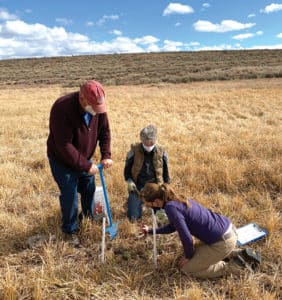
As Oregon’s rarest grass, and among the rarest grasses in the United States, Oregon semaphore grass has only a handful of naturally occurring populations in Eastern Oregon. Due to the rarity of this grass, and due to habitat loss, the Oregon Department of Agriculture (ODA) began reintroduction efforts in the early 2000s. Over the next 15 years, the only introductions that proved successful were plantings on Burns Paiute land in the Logan Valley.
In 2018 the Burns Paiute Tribe’s Natural Resources Program received a permit to internally manage the semaphore plantings. Then in 2019, in an effort to support the conservation of this rare grass and support the Burns Paiute Tribe (BPT), Bird Alliance of Oregon recruited volunteers to plant thousands of semaphore tillers (small new plants that grow from underground nodes in the semaphore rhizome) in 19 new semaphore plots along sloughs and low, moist areas in the wet meadows of the Logan Valley.
By the summer of 2020, 11 of the 19 plots appeared successful. However, it was unclear what was causing these plots to succeed or fail. Plots that were predicted to do well failed, and plots that were predicted to fail seemed to be thriving. Previous work has shown that wetter soils and sunnier sites seem to do better, but these studies had limited data and only measured soil moisture once a year.
To better understand what environmental factors influence the success of Oregon semaphore grass, the BPT Natural Resources folks started a new partnership. In 2020, the BPT Natural Resources Department partnered with botanists from the Eastern Oregon Agricultural Research Center (EOARC) to study survival and spread of Oregon semaphore grass at Logan Valley. That fall, BPT staff and EOARC scientists created 33 new semaphore plots. Bird Alliance of Oregon once again recruited volunteers, primarily from Harney County, to plant thousands of young semaphore grass tillers in these 33 new plots. The data obtained from this project will guide future plantings not only for BPT but also for other land managers interested in preserving this rare and special plant.

These semaphore plantings are one of the many Eastern Oregon stewardship opportunities that Bird Alliance of Oregon plans every year. Our volunteers play an important role in supporting the Burns Paiute Tribe with their semaphore grass restoration project. In 2022 we will be once again helping the Tribe’s staff, and local scientists, with planting this rare and beautiful grass. If you are interested in learning about future stewardship opportunities, including our next semaphore grass planting effort, please contact Teresa Wicks at twicks@birdallianceoregon.org.



